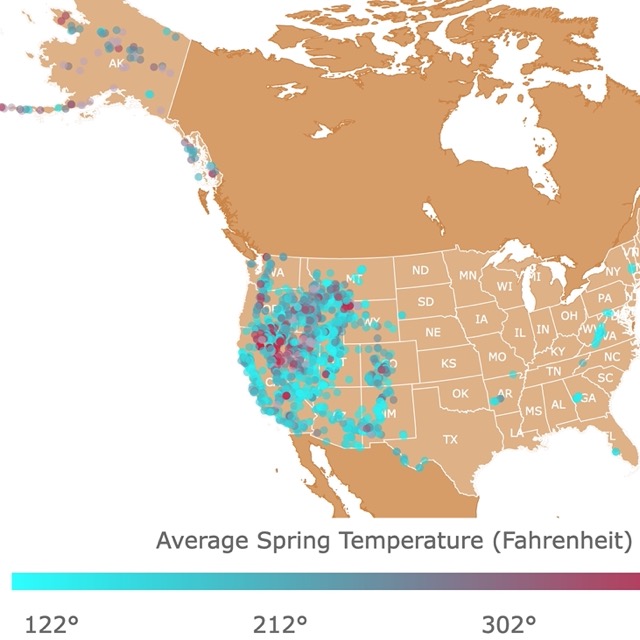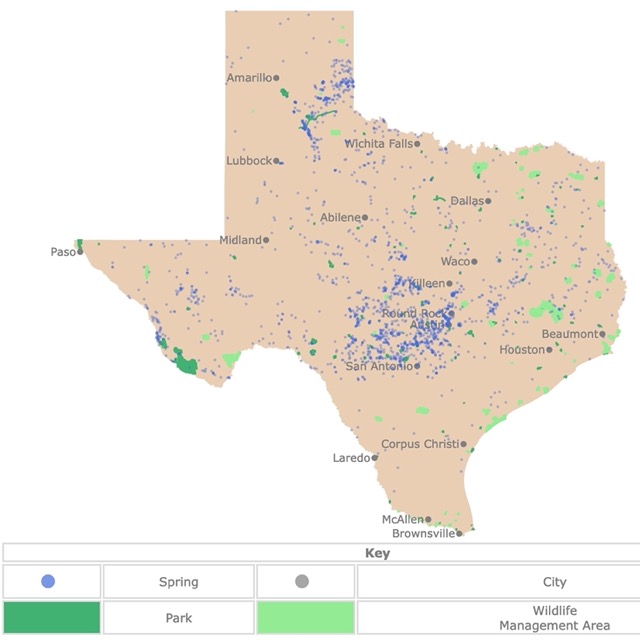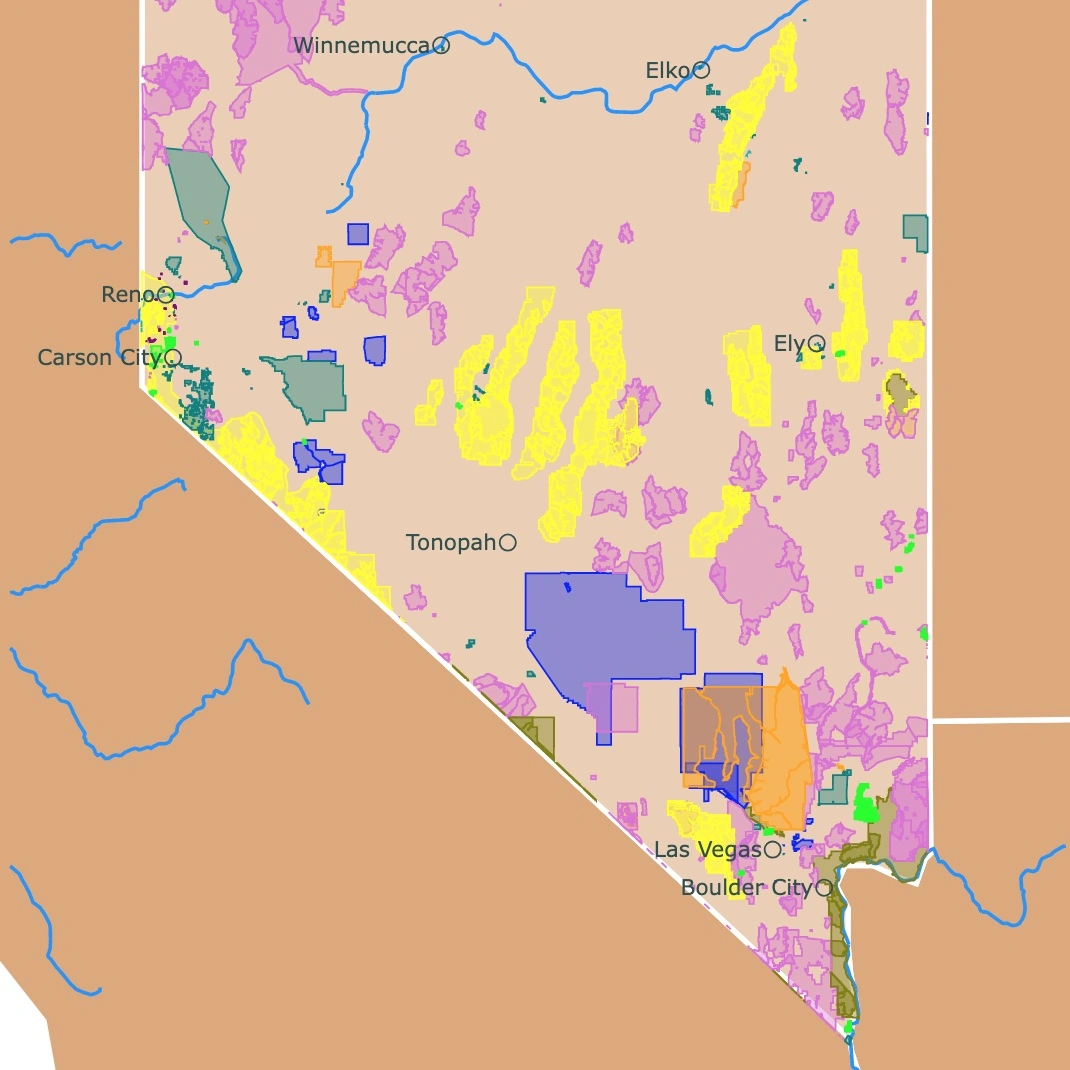Map of Nevada Hot Springs
This interactive map shows the locations of springs in Nevada. Larger circles represent higher water flow. Light blue circles represent colder springs. Fuchsia circles, indicate warmer spring temperatures. The map also shows major cities and rivers in the state for context. For more detail zoom in. For Names, precise Temperature, Water Volume Flow, and other factors hover over the site. For more information scroll down.
Hot Springs of Nevada Map
This map shows the State of Nevada and its hot springs. It displays 233 springs, but there are over 300 throughout the state. Nevada is the state with the most springs in the United States of America!
With over 70,000 acres of public land, Nevada has the most public land in the conterminous U.S., therefore, most of the springs have public access.
Having said that, not all springs are open for public use, some are on private property. Therefore visitors must be respectful of private land.

From the map, it is apparent that hotter springs have lower volume flow, and larger springs have cooler temperatures.
Most of these values were measured years ago. Some names and measurements have likely changed.
Many articles attempt to show the best springs in Nevada. This map wants to show them all and their main environmental factors.
Not all sites have all the information. Small circles had no water flow measurement. Light blue sites had no temperature measurement. These sites have their temperature labeled as 32°F and no Celsius values.
Total Dissolved Solids (TDS) are inorganic salts and small amounts of organic matter present in solution in water. The main constituents are usually calcium, magnesium, sodium, potassium, carbonate, chloride, sulfate, and nitrate, which are easily dissolved in hot spring waters and are high in some of these sites.
These constituents are attributed healing properties, and wellbeing. Nevertheless, it is also likely that the soothing warm waters produce that effect.
Hot water can hold more dissolved solids than cold water and this is why warmer waters have more minerals dissolved.
As seen on the map, most springs are far from cities. The furthest from cities, the least crowded. You may need a 4x4 vehicle to reach some sites. Others are just accessible on foot.
Many are wholes on the ground, others are stock tanks, but most are rustic. Reno Gazette
Nevada Hot Springs Origins
Most of Nevada is located in the Great Basin, a 200,000 miles2 area that drains internally. The Great Basin covers most of Nevada, and parts of Utah.
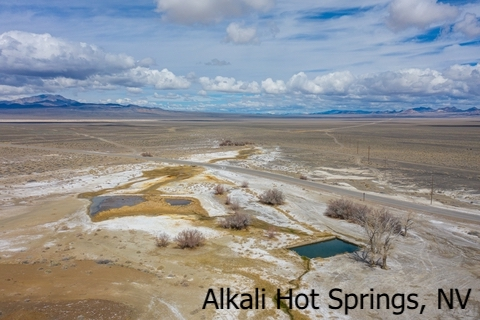
Rainfall from the Great Basin does not reach the ocean. Because of the area's arid climate, a lot of the water evaporates. Nevertheless, some of the rainwater makes it into hot springs, as it seeps through the ground.
The Great Basin is the result of the area's geologic history, which stretched the region, creating basins and valleys. The outcome is that the Earth's Crust is thinner in this basin.
The heat from the Earth's Mantle is closer and provides a heat source for geothermal systems in the area, and a large number of hot springs. PBS Vegas
Nevada's geothermal energy is also used by 24 power plants that take advantage of spring waters that are above boiling temperature. In fact, Nevada is the second-largest producer of geothermal electricity in the U.S.
This privileged location gives Nevada a high potential for more powerplants and renewable energy sources. PBS Vegas
Things to Avoid in Nevada Springs
While you do your research on the springs, make sure you keep in mind these factors, before you begin your trip.
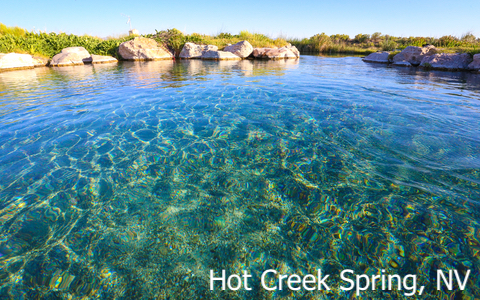
Spring pH was measured in a laboratory. Therefore, they might be slightly different on site. Fortunately, pH values in Nevada springs are not extreme, so they are not a reason for concern.
Some hot springs may have Arsenic and are dangerous to humans, especially if swallowed.
If you bring a pet, remember they will also want to jump in, and the warnings also apply to them.
Nevada Springs High Temperatures
The ideal water temperature to soak in, is between 90°F and 100°F (32°C and 37°C). Temperatures above 104°F (40°C) can be dangerous.
Make sure you take a thermometer. The temperature of the pool may vary between the vent and the edges. It might be too hot close to the vent, but just right at the edges.
It is not rare for spring temperature to change within six months. Another reason to take a thermometer and check the temperature before you take a plunge.
Hot Springs With Strong Odors
Hot springs may have no smell to a strong odor.
Many underground rocks contain sulfur, especially those that have been exposed to volcanic gas. Sulfur minerals can produce a chemical called hydrogen sulfide (H2S).
You may have encountered hydrogen sulfide as the gas that contributes to the smell of rotten eggs, farts, and bad wine. Large amounts of it are commonly found underground, where it dissolves in hot spring water.
Hydrogen sulfide also results from the decomposition of plant and animal tissue.
When the hot spring water rises the water loses some heat, this is when the hydrogen sulfide molecules become less soluble and release as gas. Because hydrogen sulfide is heavier than air, the smell tends to linger instead of quickly dissipating.
Small concentrations of hydrogen sulfide can be detected by the human olfactory system, and are not harmful to human health. But higher concentrations can be harmful.
Long exposures to concentrations of 2ppm can result in fatigue, headache, loss of appetite, weight loss, and even diarrhea. Short exposure to 100ppm may cause eye irritation and a soar throat. From there on it is quite harmful to human health.
In a few words, the harmful effects of hydrogen sulfide lay in the fact that it binds to proteins in the human bloodstream, which are in charge of respiration. This binding results in the asphyxiation of cells. Skeptical Chemist.
The best way to determine if a spring has high concentrations of Hydrogen Sulfide is by its smell. Water tests have to be done on site, as the chemical is released when in contact with air.
If the smell is strong just avoid it altogether.
Red Spider Mites in Springs
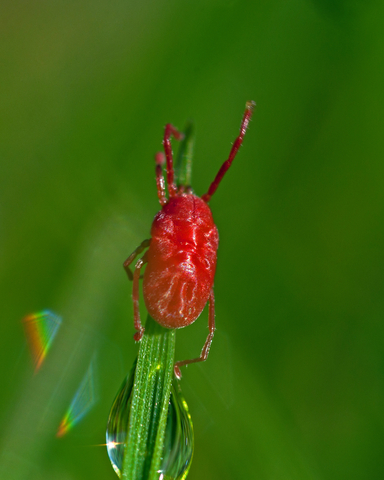
A common dweller of hot springs is the Red Spider Mite (RSM). They are barely visible to the naked eye, but they live on top of rocks of hot springs around the northwest.
These creatures cling to the body, even clothing, and towels close to the pools. They bite and lay eggs on your skin. The bites leave itchy sores that can last a couple of weeks.
A good way to check for their presence is to soak one finger and pull it out. This will make it easier to find them. If they are present is better to just go to the next spring.
If you missed them and got bites, it is advisable to use itch relief cream and not scratch the bites. Source: http://www.idahohotsprings.com/education/hot-springs-red-spider-mites.htm
Hot Spring Amoeba
The spring Amoeba occurs in very rare cases, but it is a deadly parasite, and it is important to keep in mind before spring hopping.
This organism lives in warm water of rock pits, mud puddles, warm rivers, ponds, untreated swimming pools, aquariums, lakes, rivers, and springs in the West.
These are brain eating-amoeba. The amoeba enters through the nose, then goes to the bloodstream and reaches the brain.
Before heading to a spring, make sure there are no reported cases in the area. ABC
Also, keep in mind that soaking your head in the spring is not the smartest idea. Just soak up to your shoulders.
Popular Springs in Nevada
Here is a list of popular hot springs in Nevada. Nevertheless, hidden gems are out there for you to find.
No matter where they are located, leave the area clean and take the garbage with you. If possible pick up trash if you see it. Leave the spring better than you found it!
Make sure you camp at least 100 yards (91m) away from water sources. These places are for sharing with humans and wildlife. Travel Nevada
Dogs are great companions but watch out, they might jump in hot waters or waters with parasites. So your best friend might be better at home.
As in other natural sources of water, don't take glass. If it breaks it can cut someone.
Spencer Hot Springs
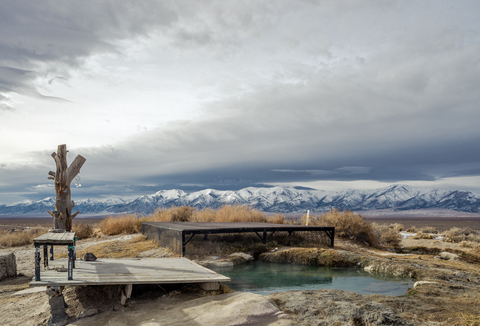
Spencer Hot Springs is located in Big Smoky Valley, right in the middle of Nevada.
This spring is popular, because of its reliability. No matter what time of the year soakers visit it, the temperatures are perfect and the views, are amazing.
Spencer is a cluster of natural springs on public land, managed by the Nevada Bureau of Land Management. Therefore, the springs are open to the public and are accessible to all.
Fortunately, they have been improved by stewards who have made small changes to the springs.
The hot water is fed through pipes to the pools. This means visitors can control the temperature, depending on the season.
Because it is a desert it is also an ideal site to watch the stars. Spencer Hot Springs
Black Rock Hot Springs

Located in the Black Rock Desert–High Rock Canyon Emigrant Trails National Conservation Area, in Northwest Nevada. Therefore, access is free.
This is a remote desert oasis. Accessibility requires visitors to drive off-road. A 4x4 is recommended, and can only be reached a few months of the year.
Not far from this area, the "Burning Man" takes place every year.
The springs reach one of two connected lagoons. The larger lagoon is for soakers, it has a dock and a shallow mud bottom.
The water temperature may vary with the season.
You can camp here but only 500 feet (152m) from the hot springs. Black Rock Hot Springs
Bog Hot Springs

Located Northwest of the state, close to the border with Oregon. It is situated between the Pueblo Mountains and Steens Mountain.
The water source is very hot but it reaches a creek that stays warm. The spring water cools down as it flows and fills several pools with sandy bottoms.
Cases of Red Spider Mites have been reported here.
The site is private but open for soaking. Just check before you arrive.
Rogers Springs

This spring is East of Las Vegas. North off the north shore of Lake Mead.
The water comes from the Rogers Spring Fault. Because of its importance as an ecological reserve and recreational site, this area is overlooked by the National Park Service.
The best time to soak is in the summer. When you enter Lake Mead there is an access fee.
Soldier Meadows Hot Springs
Also situated in the Black Rock Desert–High Rock Canyon Emigrant Trails National Conservation Area, in Northwest Nevada.
This area was part of the Applegate Trail, which brought people during the Gold Rush, to California and Oregon.
There are several springs along a natural hot springs creek.
The area is in a Bureau of Lands Management and has campsites available for spring hopers.
This is a fragile environment, so make sure you create little disturbance in this desert landscape. Soldier Meadows
Affiliate Disclosure
Databayou.com is a participant in the Amazon Services LLC Associates Program, an affiliate advertising program designed to provide a means for sites to earn advertising fees by advertising and linking to Amazon.com. Databayou.com also participates in affiliate programs with Clickbank, CJ, and other sites.
Gear for Spring Hopping
While spring hopping in Nevada you might find these items from Amazon quite useful.
- Merrell Men's Waterproof Hiking Boot: Remember, finding a pool in the desert, will probably be a bit messy. Waterproof boots will make the hike quite comfortable.
- Water Shoes, aqua socks: Are perfect for uneven bottom springs, and unfortunately for springs with broken glass. These shoes will protect your feet while you soak in the spring.
- Hooded Robe: This is a secret from spring hoppers, very few share. Using a rob is ideal when temperatures are close to freezing.
Resources for Nevada Hot Springs Map
The shapefiles with Nevada's state boundary lines and cities were downloaded from Natural Earth Data.
The river shapefiles were downloaded from National Weather Service.
The location and details about each spring were downloaded from the University of Nevada.
This map will be updated with new data! To receive updates on this and more nature maps join my email list!!!!!!!
Made by Luz K. Molina with D3.js.

